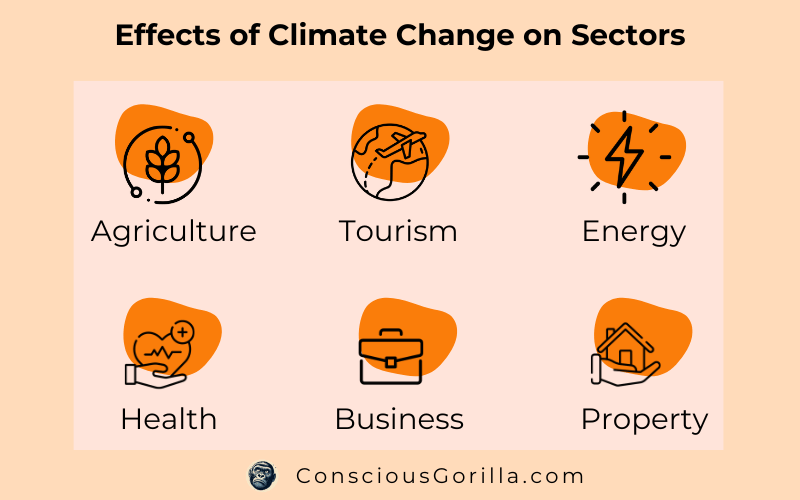Climate change isn’t just a problem for tomorrow—it’s here now, and it’s a big challenge we’re facing. According to the International Monetary Fund, in the past ten years alone, climate change has cost the world a whopping $1.3 trillion every year.
This isn’t just about the environment; it’s hitting our wallets hard too. Climate change is shaking up our economies in a big way. It’s affecting everything from farming and infrastructure to tourism and our health.
Imagine this: droughts parching fields, floods inundating cities, wildfires raging through forests, glaciers melting into oblivion, and sea levels creeping higher and higher. These are all pieces of a colossal puzzle called climate change.
While climate fluctuations have always occurred naturally, since the industrial revolution, human actions have supercharged this process. As a result, the Earth’s temperature has risen by 1.1 degrees Celsius. Climate-related disasters are draining the financial resources of nations worldwide.
So, in this blog, let’s dive a bit deeper into the effect of climate change on the worldwide economy. We’ll figure out why it’s happening and what we can do about it.
Effect of Climate Change on the Global Economy
Let’s start with a quick overview of climate change.
Climate change refers to the long-term alteration in the Earth’s weather patterns. It happens when there’s an increase in greenhouse gases, like carbon dioxide and methane, in the Earth’s atmosphere.
These gases act like a blanket, trapping heat from the sun and causing the planet’s temperature to rise. This overall warming of the Earth is what we call global warming, and the resulting shifts in weather patterns are what we refer to as climate change.
Climate change leads to a host of devastating events, such as floods, droughts, rising sea levels, melting glaciers, heat waves, and the spread of diseases. These events not only pose serious risks to communities and ecosystems but also take a toll on the economy.
The primary culprits behind climate change are fossil fuels—think coal, oil, and gas—which account for a whopping 75% of greenhouse gas emissions. Additionally, animal agriculture contributes to about 14% of these emissions.
Let’s break down where climate change is hitting our economy the hardest:

1) Agriculture: Picture this – our food source is in jeopardy. Climate change brings on disasters like droughts, scorching heatwaves, and intense floods, messing with crop yields. This messes with our food supply and makes it pricier. Imagine paying more for your groceries because growing crops is harder.
A 1°C global temperature increase could cut wheat yields by 6.0%, rice by 3.2%, maize by 7.4%, and soybean by 3.1%, hitting poorer communities the hardest. By 2050, climate change could cost us a staggering $1.7 trillion to $3.1 trillion every year.
2) Tourism: Now, think about your dream vacation spot. Climate change could turn it into a nightmare. Floods, droughts, heavy rains – all these disasters can ruin tourist hotspots. Plus, rising sea levels are a bummer for coastal vacations. Who wants to relax on a beach that might be underwater soon?
And let’s not forget the heat. With temperatures climbing, those sunny destinations might become too hot to handle. That’s not exactly what you signed up for when you booked your getaway, right?
3) Infrastructure: Extreme weather events like floods, heavy rains, wildfires, and rising sea levels, all linked to climate change, are causing significant damage globally. Estimates from the CDRI suggest that each year, between $732 billion to $845 billion worth of infrastructure and buildings could lost due to these events.
Developing countries and those with lower incomes are hit the hardest. They’re stuck with the biggest bill for fixing up what’s been wrecked. Think about it – that money could be better spent on improving lives, not just patching up the damage.
So, when we talk about climate change, it’s not just about the environment. It’s about our wallets, our vacations, and our safety too.
4) Energy: As climate change continues, we’ll likely see more floods, droughts, and heat waves, along with rising sea levels and extreme weather events. These changes will have a big impact on the energy sector. The EPA says that if global temperatures rise by 1.8°F, we might need 5-20% more energy for air conditioning.
Heatwaves will become more common, prompting people to crank up their air conditioners to stay cool, this increased demand for energy will strain the power grid, possibly leading to blackouts and financial losses for the energy industry.
Natural disasters like hurricanes, floods, and wildfires can wreak havoc on energy infrastructure. Power lines, transformers, and drilling platforms can all be damaged, and repairing them can be expensive.
Additionally, many power plants rely on water for cooling, but with droughts becoming more frequent due to climate change, these plants may struggle to get enough water. This could lead to significant economic losses for them.
5) Healthcare: As temperatures climb due to climate change, heat-related illnesses like heatstroke and dehydration become more common. This means more trips to the hospital and higher healthcare bills for many people.
Climate change doesn’t just mean hotter weather; it also brings more diseases like malaria, dengue fever, and diarrhea. These illnesses spread faster when it’s warmer, putting a bigger strain on healthcare systems and budgets.
The changing climate also messes with our food supply. It’s harder to grow crops like grains, which leads to food shortages. This hits poor folks in developing countries the hardest, making it tough for them to get enough to eat. When people don’t have enough food, their health suffers, and healthcare costs go up.
A study by the World Bank predicts that by 2030, climate change could push a whopping 132 million people into extreme poverty. Among them, 44 million could be pushed into poverty due to health-related issues caused by climate change.
6) Property Loss: Climate change-related events like bushfires, storms, floods, and coastal erosion can harm property values and lead to higher costs for property owners. Areas prone to flooding, wildfires, or severe weather may see a drop in property values.
Additionally, stronger storms, hail, and heatwaves mean more upkeep for properties, driving maintenance costs up. A report suggests that by 2061, as many as 39,000 to 46,000 properties could be at risk of coastal flooding, resulting in property losses and land damage totaling up to $1.3 billion.
7) Business Loss: Climate change profoundly impacts how businesses operate. Extreme weather events like floods, droughts, and wildfires, which are intensified by climate change, can wreak havoc on supply chains. When transportation routes become impassable and crops fail, the flow of raw materials is disrupted, leading to increased costs for businesses. As a result, consumers face higher prices and may cut back on purchases, causing financial losses for companies.
Additionally, rising sea levels, stronger storms, and extreme heat have serious implications for business infrastructure. Intense heat, for example, drives up the demand for air conditioning, straining the energy grid and causing power outages. These outages can result in significant financial losses for businesses that rely on uninterrupted power supply.
Solution
To tackle climate change effectively, we need to embrace different solutions and shift our mindset and behavior away from being solely self-centered.
Let’s explore some key solutions to combat climate change.
1) Cutting Down on Fossil Fuels:
Fossil fuels like oil, coal, and gas release a lot of carbon dioxide, a big player in global warming. Nearly 90% of this CO2 comes from burning these fuels, making up about 75% of all greenhouse gas emissions.
To tackle this problem, we need to use less coal, oil, and gas, since they’re the main culprits. According to the International Energy Agency (IEA), if we shift away from these fuels and aim to produce no more CO2 than we can absorb by 2050, we could keep global warming to just 1.5 degrees Celsius. This bold target is key to softening the worst impacts of climate change.
2) Investing in Renewable Energy:
Imagine energy that doesn’t harm our planet. That’s what renewable energy is all about. It comes from sources like the sun, wind, and water, and it creates electricity without pumping out harmful greenhouse gases like fossil fuels do.
In the U.S. back in 2022, about 4.75% of our electricity came from solar power. But by 2050, experts think the U.S. could bump that up to 20%. That’s a big leap toward cleaner energy.
3) Switching to Sustainable Transport:
Did you know that 20% of the carbon dioxide we pump into the air comes from transportation? Most of that comes from cars, trucks, planes, and ships.
But here’s the thing: we can cut down on that pollution by choosing greener ways to get around. Think electric cars, buses, trains, and even bikes. By making these choices, we can help keep our air cleaner and our planet healthier.
4) Go Vegan (Avoiding Animal Products):
Believe it or not, what we eat can also impact our planet. The animal industry, like farms where we raise animals for food, creates about 14% of all the greenhouse gases we release.
That’s where going vegan comes in. By skipping animal products like meat, milk, and eggs, and choosing plant-based alternatives instead, we can shrink our carbon footprint. Studies show that if more of us switch to a plant-based diet, we could slash greenhouse gas emissions by 50%.
5) Stop Deforestation:
Forests are like giant vacuum cleaners for carbon dioxide, sucking it out of the air and storing it away. But when we chop down trees, that stored carbon gets released back into the atmosphere, adding to climate change.
Surprisingly, a big reason for deforestation is the animal industry. By cutting down fewer trees, we can keep more carbon locked away and cut down on greenhouse gases. Experts say if we stop deforestation, we could reduce emissions by a whopping 15%.
6) Have Fewer Children:
When more people come into the world, they need more stuff, which means more greenhouse gases. It’s just math.
But here’s a surprising fact: having one fewer child can save a staggering 58.6 tons of carbon dioxide each year. To put that into perspective, giving up your car only saves about 2.4 tons a year.
7) Reduce Consumption:
On average, each person on Earth spits out about 4 tons of carbon dioxide every year. But in the U.S., it’s a lot more – about 16 tons each.
Here’s the deal: if we all cut back on what we use and choose greener options, we can make a big dent in those emissions. And by doing that, we can help protect our planet from the worst effects of climate change. It’s up to us to make the change.
More for you:
Top 5 Effects of Climate Change on Agriculture
21+ Amazing Facts About Climate Change
Conclusion
Climate change isn’t just about extreme weather or melting ice caps; it’s a threat to our way of life and the global economy. Developing countries, already vulnerable, bear the brunt of its impacts.
According to ThePrint, if current trends continue, by 2050, the world could face a significant 19% drop in average income. This isn’t just a problem for the distant future; it’s a looming crisis that demands immediate attention.
By reducing consumption, adopting a vegan lifestyle, and investing in renewable energy, sustainable agriculture, and carbon reduction efforts, we can mitigate the worst effects of climate change.
But awareness is key. We need everyone on board, spreading the word and advocating for change. So, if this blog has taught you something new, share it with your friends. Together, we can build a more resilient future for all.
As a content writer, my mission is to promote factual climate information. With collective consciousness and concerted efforts, we can make a positive impact and save our world.


Leave a Reply
You must be logged in to post a comment.